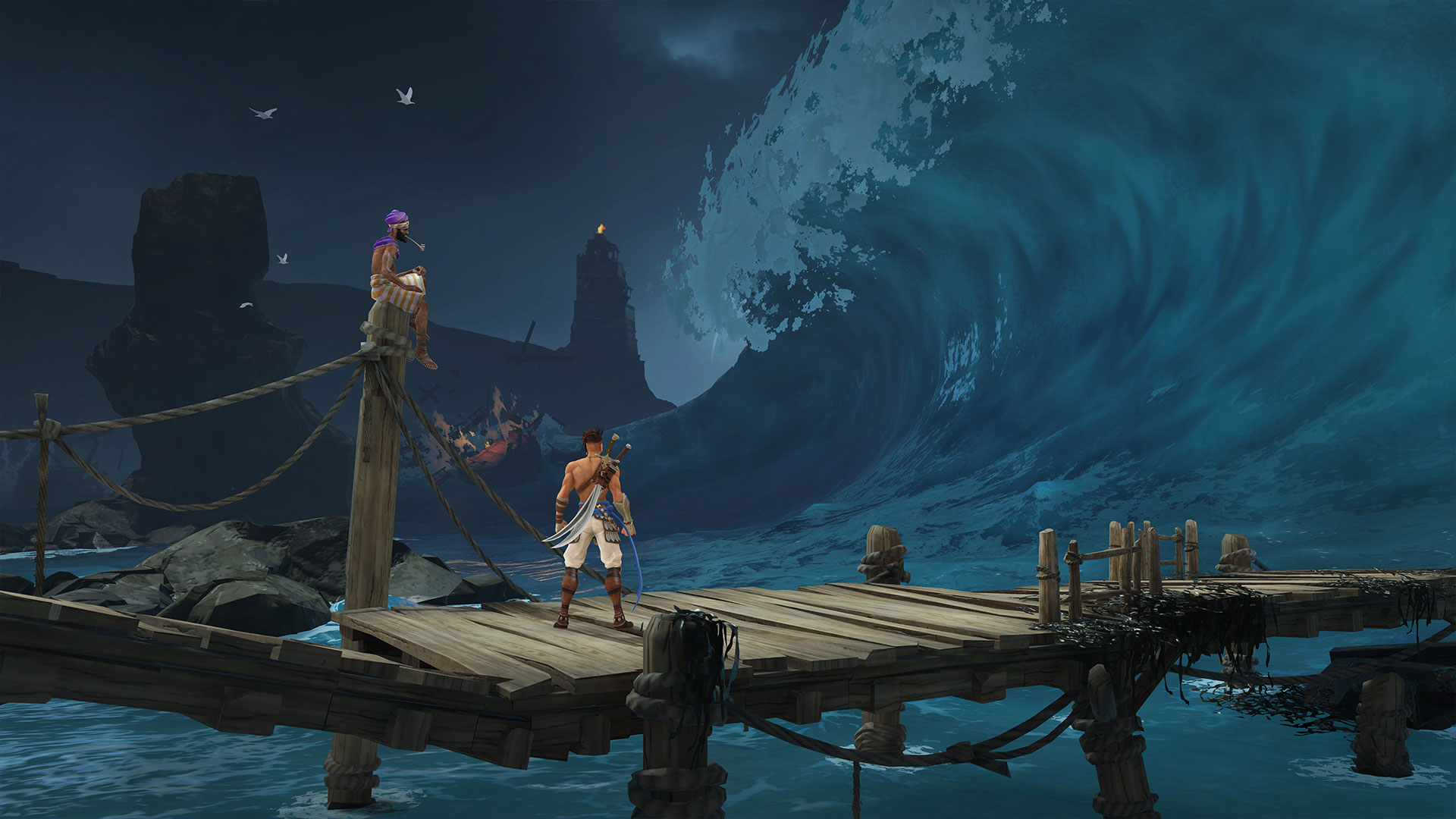GamesRadar+ Verdict
Prince of Persia: The Lost Crown is an otherwise top-tier Metroidvania game – filled with intrigue, neat brain-teasing puzzles, masterful platforming, and spectacle-fueled boss battles – that's let down by a confusing narrative that sometimes prevents it from spreading its wings.
Pros
- +
Looks absolutely stunning
- +
Boss battles are larger than life
- +
Level design and environmental puzzles are brilliant
Cons
- -
Story is needlessly complicated and convoluted
- -
Pacing occasionally suffers as a result
Why you can trust GamesRadar+
In its most inspiring moments, Prince of Persia: The Lost Crown is a wonderful Metroidvania. Its labyrinthian 2.D map is crafted with care and is intelligently balanced, brought to life by the game's vibrant color palette that's as gorgeous as it is inviting. Its environmental puzzles are challenging but rewarding, and its library of incrementally-gained, genre-staple special abilities ensure exploration feels fresh from start to finish. The Lost Crown's narrative features, on the other hand, are needlessly convoluted and too often disrupted my flow, forcefully distracting me from everything the game does so well.
Release date: January 15, 2024
Platform(s): PC, PS5, Xbox Series X, PS4, Xbox One, Nintendo Switch
Developer: Ubisoft Montpellier
Publisher: Ubisoft
I'll address the game's story in greater detail later, but the skinny here is: Prince Ghassan has been kidnapped, you fill the nimble shoes of a young warrior named Sargon, and, alongside your like-minded band of soldier buddies named The Immortals, it's up to you to save the prince and thus save the day. A series of events that I won't spoil here inevitably complicate things along the way, and while striving to overcome the antagonists of the hour, young Sargon learns a series of super-charged abilities that allow him to access new areas and overcome once impenetrable obstacles.
Mapped out

The best Metroidvania games live or die by the intricacies, intrigue, and interconnectedness of their maps, and Prince of Persia: The Lost Crown's constantly-evolving Mount Qaf is a good one. From the slimy Depths to the pitch-dark Catacombs, the sprawling Sacred Archives and the multi-tiered Citadel, each location has its own idiosyncratic style, host of hostile enemies, and treasure trove of key items and environmental puzzles. In a clear nod to the series' 35-year lineage, the latter often comprise some order of spike traps, deteriorating platforms, pressure plates, well-placed flagpoles, and time-manipulation mechanics – and when all they come together, or rather, whenever you work out how to overcome them when they come together, that's when The Lost Crown really clicks into place.
These level-set, physics-meets-mental conundrums were over and above my favorite thing about Prince of Persia: The Lost Crown, offering a shrewd understanding of what drives the Metroidvania genre beneath the facade of cool superpowers and larger than life boss battles. I've played too many games of this ilk who fail to grasp the importance of balancing intrigue in both downtime and at full speed simultaneously, but in mechanical terms The Lost Crown is bang on the money. Don't get me wrong, you'll send Sargon into battle against more ancient gods than you can shake his twin-blades at, but the journey getting there is often punctuated with masterful and intelligent platforming puzzle work.

"All of which makes Prince of Persia: The Lost Crown a bit of a conundrum in itself."
In doing so, you'll leverage Sargon's abilities and special items. His trusted Qays and Layla dual blades are the main source of the game's weighty and satisfying melee combat; whereas his Bow of Menolias, and a handful of other weapons unearthed across the map, let you mix up your offense as you go. A series of tiered Amulets boost the strength of attack and defense – with the likes of 'Blessing' increasing maximum health, and 'Wolf-Bride' converting damage taken into Athra build-up – with Athra gained by striking enemies. Once you've filled the Athra bar that sits neatly at the foot of the screen, you can unleash 'Athra Surges' that provide another layer of mix-and-match attacking options.
Back on the puzzle front, some of my favorite environmental quandaries early doors involved Sargon's 'Shadow of the Simurgh' ability, whereby the hero forms a shadow of himself that he can teleport back to after performing other duties. One puzzle to this end had me standing on a platform overlooking a spike pit, forming a shadow, dropping into the pit, firing my bow at a bell that flipped a different platform, teleporting back to my original form, and then sprinting over the flipped platform to reach a new area. And if that sounds confusing written down, let me assure you my head was absolutely spinning throughout the 15 or so minutes it took me to finally crack it. The eureka moments that follow both working out what to do in a puzzle, and then finally getting it right are second to none throughout Prince of Persia: The Lost Crown.
Talking dead


One of The Lost Crown's most endearing features is 'Memory Shards', which let you take screenshots of real-time locations, allowing you to easily annotate the map and pinpoint key areas to re-explore once tooled up with new powers. I'm sure many Metroidvania players can relate to losing their place or forgetting exactly where new pathways can be unlocked amidst an ever-expanding map, and therefore Memory Shards make staying on track so much easier and ensure things continue moving forward at a nice pace.
As excellent as so much of Prince of Persia: The Lost Crown is, it does have a tendency to stumble into pitfalls because of its story. Given how well the game understands the importance of linking its quieter moments to its loudest, for me it totally misses the mark with its narrative interjections. Dealing with themes of time and space and the manipulation of both, The Lost Crown's story is complicated from the outset, but it also does little to make us care about the characters in question – barely building our relationship with protagonist Sargon from the outset, and doing very little to make us care about the satellite stars who aid and obstruct his path over the course.
Worse still, I too often felt like Prince of Persia: The Lost Crown was forcing its story on me, interrupting everything it does so well to share something about Sargon or someone else that rarely felt integral to my progression. I'm always careful when comparing genre stablemates to each other, but where the likes of Hollow Knight or the Blasphemous series tell much of their stories through exploration, on-the-ground discovery, and how players might interpret the things they uncover, The Lost Crown is too often determined to talk at you, and pacing suffers as a result.
All of which makes Prince of Persia: The Lost Crown a bit of a conundrum in itself. It's a great Metroidvania game, full of surprise and spectacle, uber-tough and hulking boss fights, a sprawling map that's smartly tied together, with abilities that are unlocked via puzzles that are consistently tough but never unfair. When it's allowed to breathe, it excels as one of the best Metroidvania games I've played in recent years, and yet all at the same time is suffocated by an underwhelming story and awkward cutscenes that too often disrupt the flow that underpins the Metroidvania genre itself. When you're allowed to be in the zone, it's wonderful. When you're forcibly removed from it, it's such a waste.
All of this said, I'd still recommend Prince of Persia: The Lost Crown to the Metroidvania heads among us, as well as longstanding Prince of Persia fans whose experience with the series stretches back to the late '80s/early '90s. For those wanting more in the same vein as 3D adventures like The Sands of Time, this ain't it. But it is a return to relative form for a series whose last mainline outing landed 14 years ago – it's just disappointing that this very good game was held back from true greatness.
Disclaimer
Prince of Persia: The Lost Crown was reviewed on PS5, with code provided by the publisher.
More info
| Genre | Metroidvania |

Joe Donnelly is a sports editor from Glasgow and former features editor at GamesRadar+. A mental health advocate, Joe has written about video games and mental health for The Guardian, New Statesman, VICE, PC Gamer and many more, and believes the interactive nature of video games makes them uniquely placed to educate and inform. His book Checkpoint considers the complex intersections of video games and mental health, and was shortlisted for Scotland's National Book of the Year for non-fiction in 2021. As familiar with the streets of Los Santos as he is the west of Scotland, Joe can often be found living his best and worst lives in GTA Online and its PC role-playing scene.



